Idle MITSUBISHI GALANT 1989 Service User Guide
[x] Cancel search | Manufacturer: MITSUBISHI, Model Year: 1989, Model line: GALANT, Model: MITSUBISHI GALANT 1989Pages: 1273, PDF Size: 37.62 MB
Page 96 of 1273

. .CrackII-46ENGINE
(2) Cracked back surface rubber.
(3) Cracked or separated canvas.
(4) Cracked tooth bottom.
(5) Cracked side.
Separation
Crack
’7EN207
Rounded belt side
Abnormal wear (fluffy canvas fiber)
7EN208
Rubber
exposed
Tooth mlsslng
and
canvas fiber exposed
7EN209
6EN0159
c \/Ga//
@E3%00
t 6EN0280(6) Abnormal wear on side.
NOTE
Normal belt should have clear-cut sides as if cut by a sharp
knife.
(7) Abnormal wear on teeth.
Initial stage:Canvas on load side tooth flank worn (Fluffy canvas fib-
ers, rubber gone and color changed to white, and un-
clear canvas texture)
Final stage: Canvas on load side tooth flank worn down and rubber
exposed (tooth width reduced)
(8) Missing tooth.
TENSIONER PULLEY AND IDLER PULLEY
(1) Turn the pulleys to check for possible binding, excessive
play, and unusual noise. Replace the pulley if any of these
defects is evident.
(2) Replace if there is a grease leak.
AUTO TENSIONER
(1) Check the auto tensioner for possible leaks and replace as
necessary.
(2) Check the rod end for wear or damage and replace as necessary.
TSB Revision
Page 101 of 1273
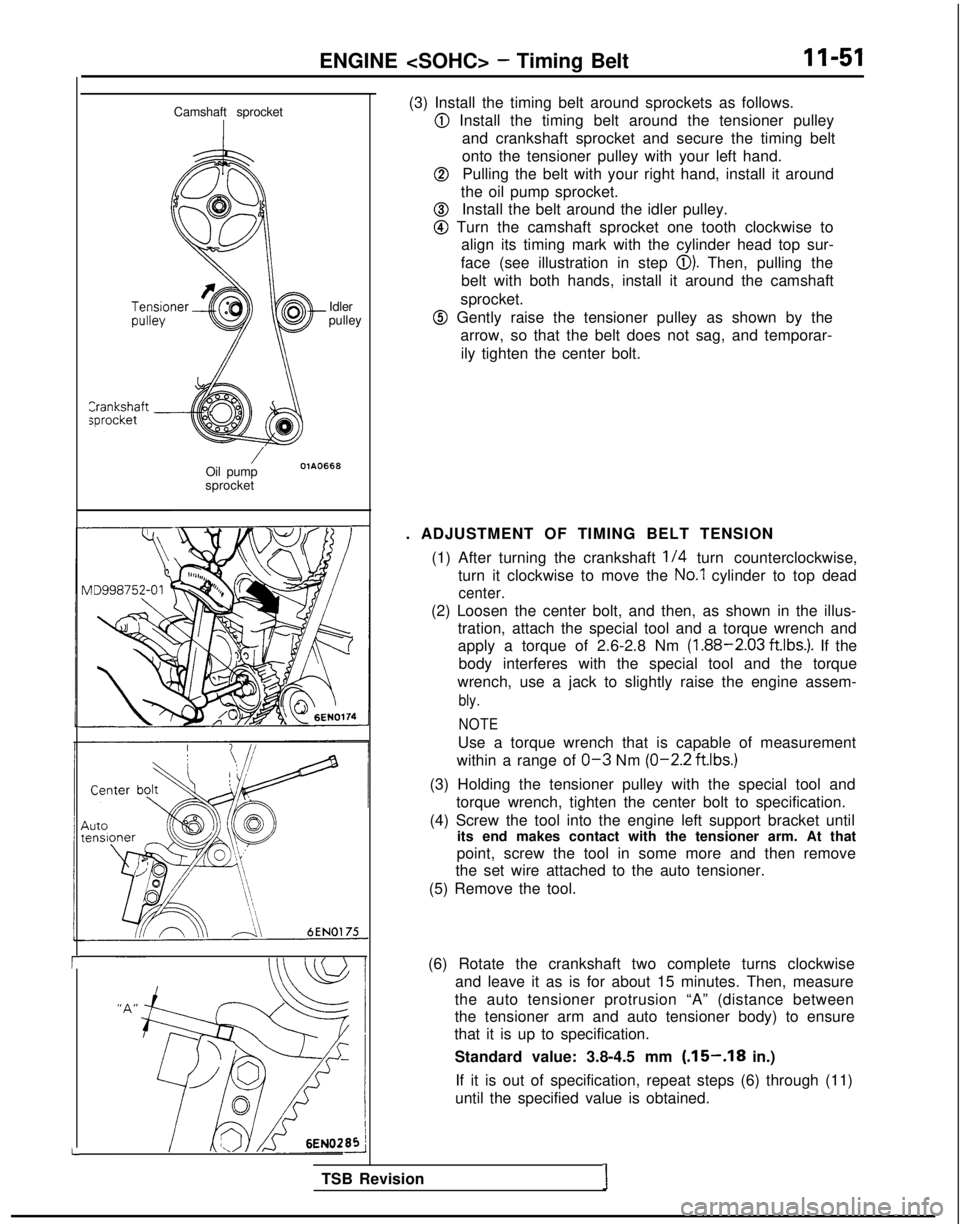
ENGINE
r
L Camshaft sprocket
Idler
pulley
/Oil pumpOlA0668
sprocket
6EN0175
(3) Install the timing belt around sprockets as follows.
@ Install the timing belt around the tensioner pulley
and crankshaft sprocket and secure the timing belt
onto the tensioner pulley with your left hand.
@Pulling the belt with your right hand, install it around
the oil pump sprocket.
@Install the belt around the idler pulley.
@ Turn the camshaft sprocket one tooth clockwise to align its timing mark with the cylinder head top sur-
face (see illustration in step
0). Then, pulling the
belt with both hands, install it around the camshaft
sprocket.
@ Gently raise the tensioner pulley as shown by the arrow, so that the belt does not sag, and temporar-
ily tighten the center bolt.
. ADJUSTMENT OF TIMING BELT TENSION (1) After turning the crankshaft
l/4 turn counterclockwise,
turn it clockwise to move the
No.1 cylinder to top dead
center.
(2) Loosen the center bolt, and then, as shown in the illus- tration, attach the special tool and a torque wrench and
apply a torque of 2.6-2.8 Nm
(1.88-2.03 ft.lbs.). If the
body interferes with the special tool and the torque
wrench, use a jack to slightly raise the engine assem-
bly.
NOTE
Use a torque wrench that is capable of measurement
within a range of
O-3 Nm (O-2.2
ftlbs.)
(3) Holding the tensioner pulley with the special tool and
torque wrench, tighten the center bolt to specification.
(4) Screw the tool into the engine left support bracket until its end makes contact with the tensioner arm. At that
point, screw the tool in some more and then remove
the set wire attached to the auto tensioner.
(5) Remove the tool.
(6) Rotate the crankshaft two complete turns clockwise and leave it as is for about 15 minutes. Then, measure
the auto tensioner protrusion “A” (distance between
the tensioner arm and auto tensioner body) to ensure
that it is up to specification.
Standard value: 3.8-4.5 mm
(.15-.18 in.)
If it is out of specification, repeat steps (6) through (11)
until the specified value is obtained.
TSB Revision
I
Page 103 of 1273
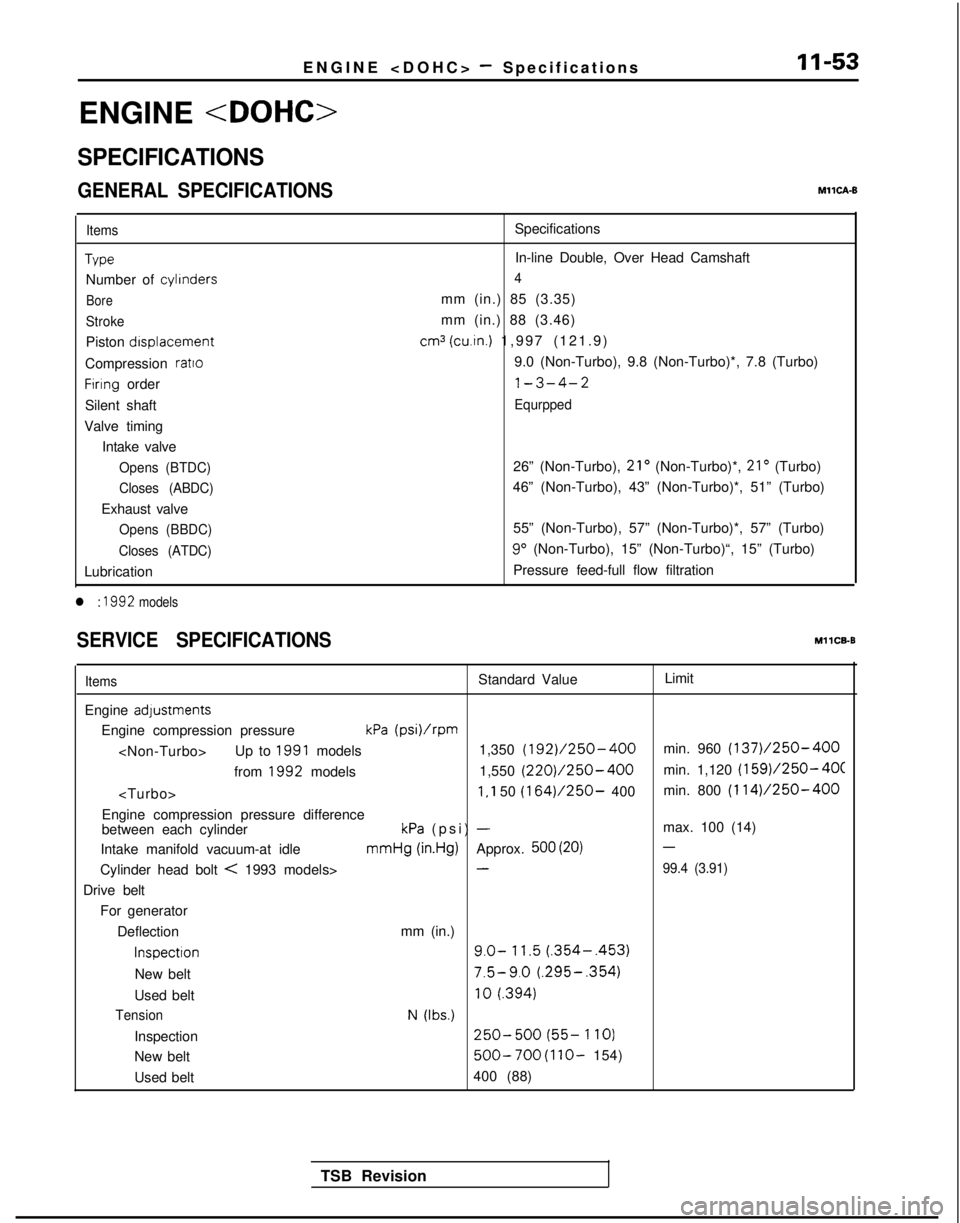
ENGINE
s
ENGINE
SPECIFICATIONS
GENERAL SPECIFICATIONSMllCA-6
Items
Tvpe
Number of
cylinders
Bore
Stroke
Piston
drsplacement
Compression
ratto
Firing order
Silent shaft
Valve timing Intake valve
Opens (BTDC)
Closes (ABDC)
Exhaust valve
Opens (BBDC)
Closes (ATDC)
Lubrication
l : 1992 models
Specifications
In-line Double, Over Head Camshaft
4
mm (in.) 85 (3.35)
mm (in.) 88 (3.46)
cm3 (cu.in.) 1,997 (121.9
)
9.0 (Non-Turbo), 9.8 (Non-Turbo)*, 7.8 (Turbo)
l-3-4-2
Equrpped
26” (Non-Turbo), 21’ (Non-Turbo)*, 21’ (Turbo)
46” (Non-Turbo), 43” (Non-Turbo)*, 51” (Turbo)
55” (Non-Turbo), 57” (Non-Turbo)*, 57” (Turbo) 9”
(Non-Turbo), 15” (Non-Turbo)“, 15” (Turbo)
Pressure feed-full flow filtration
SERVICE SPECIFICATIONSMllCB-B
ItemsStandard Value Limit
Engine
adystments
Engine compression pressurekPa (psi)/rpm
from 1992
models 1,550 (220)/250-400min. 1,120 (159)/250- 4OC
Engine compression pressure difference
between each cylinderkPa (psi) -max. 100 (14)
Intake manifold vacuum-at idle mmHg
(in.Hg)Approx. 500 (20)-
Cylinder head bolt < 1993 models>-99.4 (3.91)
Drive belt
For generator
Deflection mm (in.)
Inspectron9.0- 11.5 (.354-.453)
New belt7.5-9.0 (.295-.354)
Used belt10
f.394)
TensionN (Ibs.)
Inspection250-500 (55- 1
IO)
New belt
500-700 (1 lo- 154)
Used belt 400 (88)
TSB Revision
Page 107 of 1273
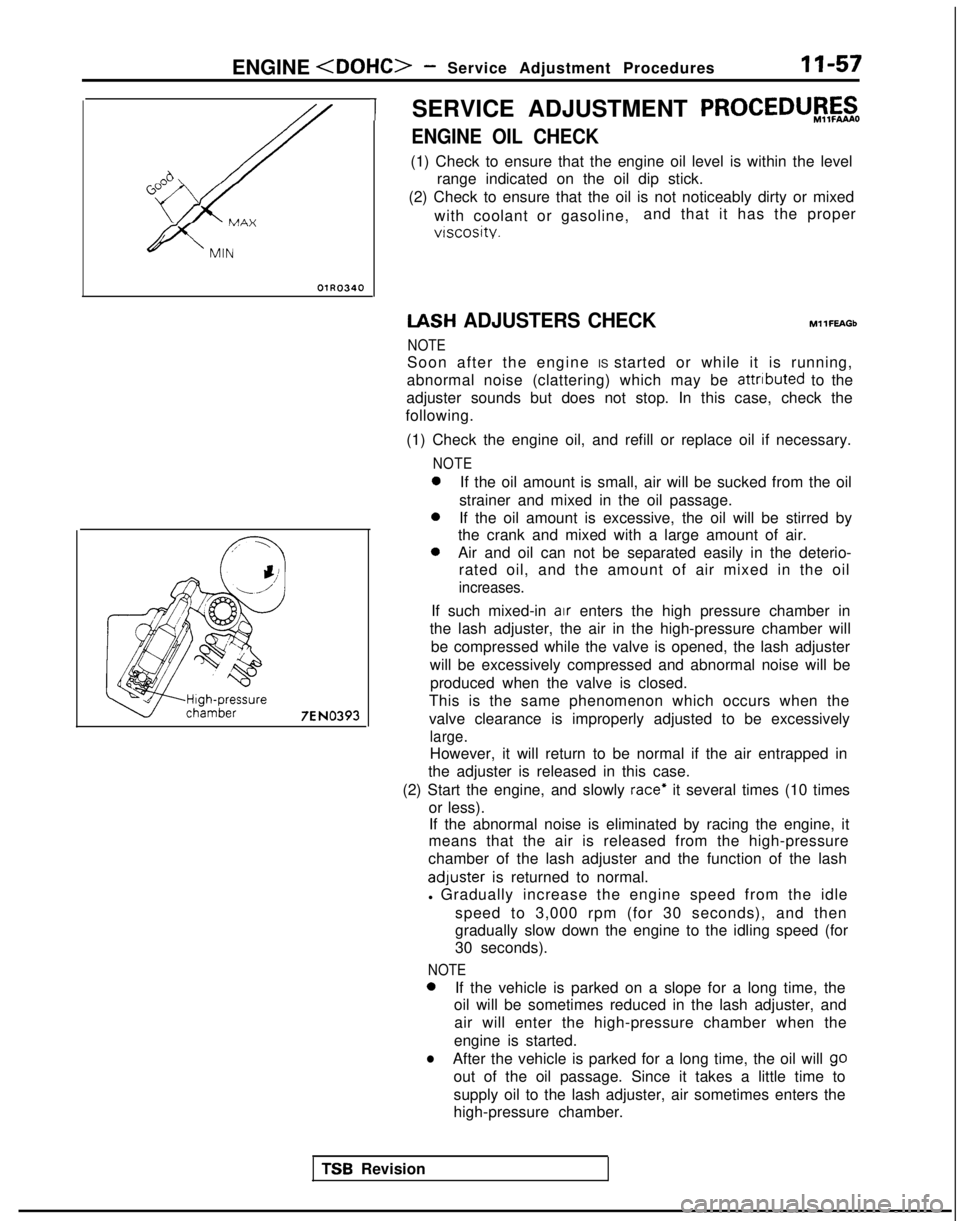
ENGINE
OlR0340
7EN0393
1SERVICE ADJUSTMENT PROCEDUBFzo
ENGINE OIL CHECK
(1) Check to ensure that the engine oil level is within the level
range indicated on the oil dip stick.
(2) Check to ensure that the oil is not noticeably dirty or mixed
with coolant or gasoline, and that it has the proper
vtscosity. IASH
ADJUSTERS CHECK
NOTE MllFEAGb
Soon after the engine IS started or while it is running,
abnormal noise (clattering) which may be attributed
to the
adjuster sounds but does not stop. In this case, check the
following.
(1) Check the engine oil, and refill or replace oil if necessary.
NOTE 0
If the oil amount is small, air will be sucked from the oil
strainer and mixed in the oil passage. 0
If the oil amount is excessive, the oil will be stirred by
the crank and mixed with a large amount of air. 0
Air and oil can not be separated easily in the deterio-
rated oil, and the amount of air mixed in the oil
increases.
If such mixed-in air enters the high pressure chamber in
the lash adjuster, the air in the high-pressure chamber will
be compressed while the valve is opened, the lash adjuster
will be excessively compressed and abnormal noise will be produced when the valve is closed.
This is the same phenomenon which occurs when the
valve clearance is improperly adjusted to be excessively
large.
However, it will return to be normal if the air entrapped in
the adjuster is released in this case.
(2) Start the engine, and slowly
race* it several times (10 times
or less). If the abnormal noise is eliminated by racing the engine, it
means that the air is released from the high-pressure
chamber of the lash adjuster and the function of the lash adluster
is returned to normal.
l Gradually increase the engine speed from the idle
speed to 3,000 rpm (for 30 seconds), and then
gradually slow down the engine to the idling speed (for
30 seconds).
NOTE 0
If the vehicle is parked on a slope for a long time, the
oil will be sometimes reduced in the lash adjuster, and
air will enter the high-pressure chamber when the
engine is started.
lAfter the vehicle is parked for a long time, the oil will go
out of the oil passage. Since it takes a little time to
supply oil to the lash adjuster, air sometimes enters the
high-pressure chamber.
TSR Revision
Page 108 of 1273
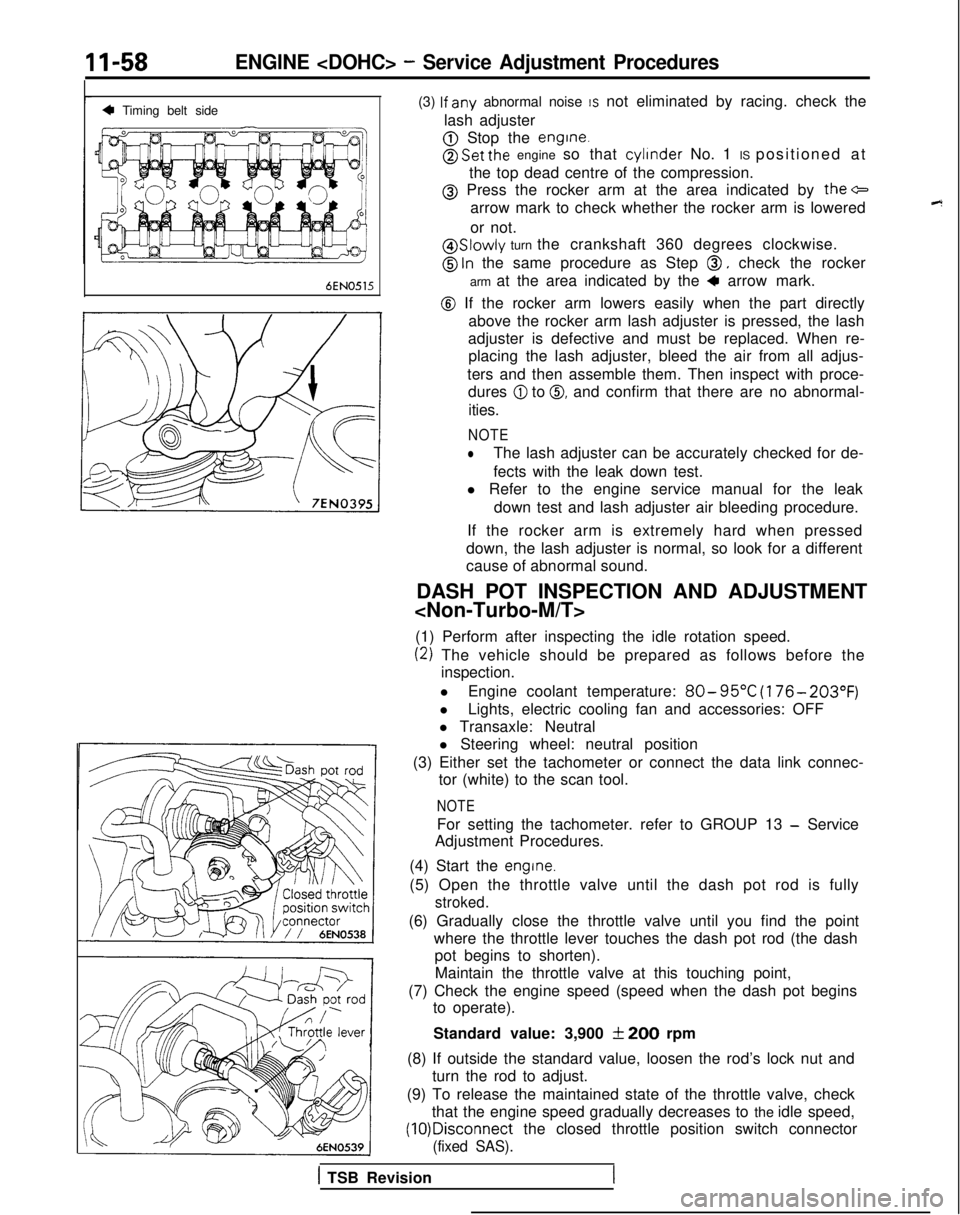
11-58ENGINE
4 Timing belt sideI
6EN0515
(3) lf
any abnormal noise IS not eliminated by racing. check the
lash adjuster
@ Stop the engine.
@ Set the engine so that cylinder
No. 1 IS positioned at
the top dead centre of the compression.
@ Press the rocker arm at the area indicated by the+
arrow mark to check whether the rocker arm is lowered
or not.
@ Slowly turn the crankshaft 360 degrees clockwise.
@ ln the same procedure as Step 0, check the rocker
arm at the area indicated by the
4 arrow mark.
@ If the rocker arm lowers easily when the part directly above the rocker arm lash adjuster is pressed, the lash
adjuster is defective and must be replaced. When re- placing the lash adjuster, bleed the air from all adjus-
ters and then assemble them. Then inspect with proce- dures
@I to 0, and confirm that there are no abnormal-
ities.
NOTE
lThe lash adjuster can be accurately checked for de-
fects with the leak down test.
l Refer to the engine service manual for the leak
down test and lash adjuster air bleeding procedure.
If the rocker arm is extremely hard when pressed
down, the lash adjuster is normal, so look for a different
cause of abnormal sound.
DASH POT INSPECTION AND ADJUSTMENT
(1) Perform after inspecting the idle rotation speed.
(2) The vehicle should be prepared as follows before the inspection.
l Engine coolant temperature:
80- 95°C
(176- 203°F)
lLights, electric cooling fan and accessories: OFF
l Transaxle: Neutral
l Steering wheel: neutral position
(3) Either set the tachometer or connect the data link connec- tor (white) to the scan tool.
NOTE
For setting the tachometer. refer to GROUP 13 - Service
Adjustment Procedures.
(4) Start the
engine.
(5) Open the throttle valve until the dash pot rod is fully
stroked.
(6) Gradually close the throttle valve until you find the point where the throttle lever touches the dash pot rod (the dashpot begins to shorten).
Maintain the throttle valve at this touching point,
(7) Check the engine speed (speed when the dash pot begins to operate).
Standard value: 3,900
f 200 rpm
(8) If outside the standard value, loosen the rod’s lock nut and turn the rod to adjust.
(9) To release the maintained state of the throttle valve, check that the engine speed gradually decreases to the idle speed, (10)Disconnect
the closed throttle position switch connector
(fixed SAS).
1 TSB Revision
Page 110 of 1273
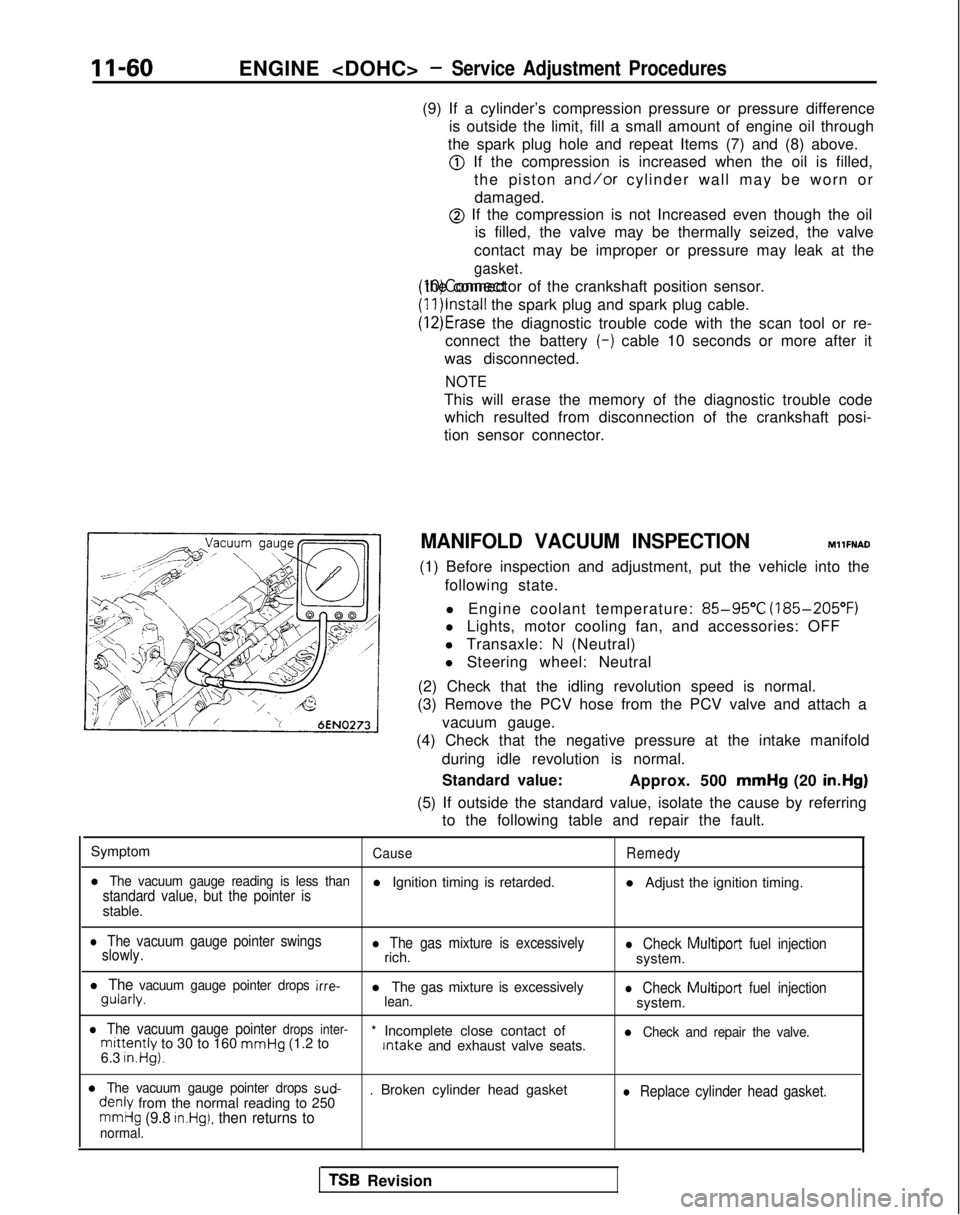
II-60ENGINE
(9) If a cylinder’s compression pressure or pressure differenceis outside the limit, fill a small amount of engine oil through
the spark plug hole and repeat Items (7) and (8) above.
@ If the compression is increased when the oil is filled, the piston
and/or cylinder wall may be worn or
damaged.
@ If the compression is not Increased even though the oil is filled, the valve may be thermally seized, the valve
contact may be improper or pressure may leak at the
gasket. (10)Connect the connector of the crankshaft position sensor.
(1l)lnstall
the spark plug and spark plug cable.
(12)Erase the diagnostic trouble code with the scan tool or re-
connect the battery (-)
cable 10 seconds or more after it
was disconnected.
NOTE
This will erase the memory of the diagnostic trouble code which resulted from disconnection of the crankshaft posi-
tion sensor connector.
MANIFOLD VACUUM INSPECTION MllFNAD
(1) Before inspection and adjustment, put the vehicle into the following state.
l Engine coolant temperature:
85-95°C (185-205°F)
l Lights, motor cooling fan, and accessories: OFF
l Transaxle:
N (Neutral)
l Steering wheel: Neutral
(2) Check that the idling revolution speed is normal.
(3) Remove the PCV hose from the PCV valve and attach a
vacuum gauge.
(4) Check that the negative pressure at the intake manifold
during idle revolution is normal.
Standard value: Approx. 500 mmHg
(20 in.Hg)
(5) If outside the standard value, isolate the cause by referring to the following table and repair the fault.
Symptom
CauseRemedy
l The vacuum gauge reading is less thanstandard value, but the pointer isl Ignition timing is retarded. l Adjust the ignition timing.
stable.
l The vacuum gauge pointer swings
slowly.l The gas mixture is excessivelyrich.l Check Multiport fuel injectionsystem.
l The vacuum gauge pointer drops irre- gularly.
l The gas mixture is excessively
lean.l Check Multiport
fuel injectionsystem.
l The vacuum gauge pointer drops inter-mittently to 30 to 160 mmHg
(1.2 to * Incomplete close contact of Intake
and exhaust valve seats.l Check and repair the valve.
6.3 in.Hg).
l The vacuum gauge pointer drops sud- denly
from the normal reading to 250 . Broken cylinder head gasketl Replace cylinder head gasket.
mmHg (9.8 in.Hg), then returns tonormal.
TSB Revision
Page 130 of 1273
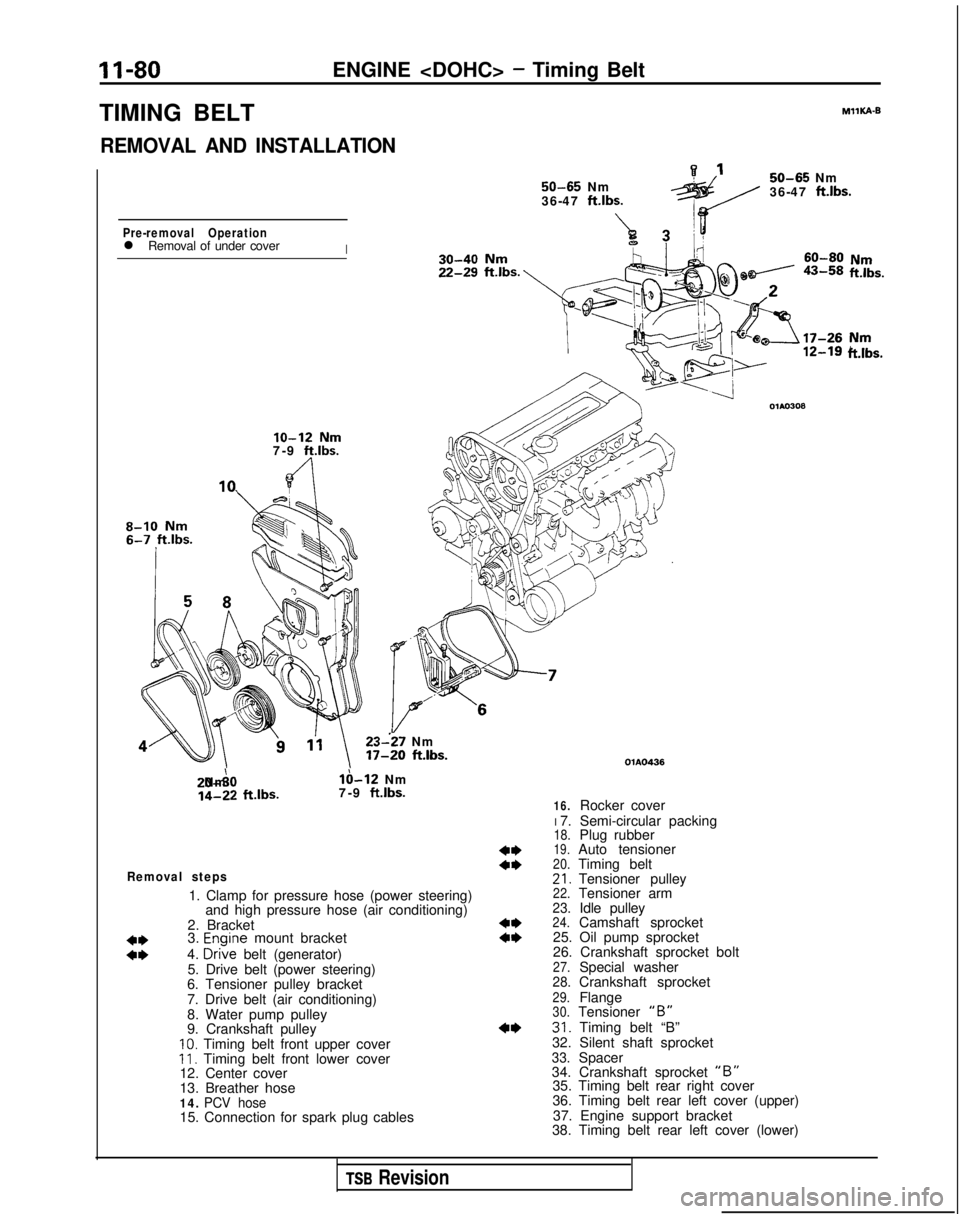
II-80ENGINE
TIMING BELT
REMOVAL AND INSTALLATION 50-65
Nm
36-47 ftlbs.
A7Pre-removal Operationl Removal of under coverI MIlKA-B
50-65
Nm
36-47
ft.lbs.
ii!&.
lo-12 Nm7-9 ft.lbs.
8-10 Nm
23--27 Nm 17-20
ft.lbs. 20-A0 Nm
lb-12 Nm
14-22
ftlbs.
7-9 ft.lbs.
Removal steps
1. Clamp for pressure hose (power steering)
and high pressure hose (air conditioning)
2. Bracket
3.
Enoine mount bracket
ii4. D&e belt (generator)
5. Drive belt (power steering)
6. Tensioner pulley bracket
7. Drive belt (air conditioning)
8. Water pump pulley
9. Crankshaft pulley
10. Timing belt front upper coverII. Timing belt front lower cover
12. Center cover
13. Breather hose
14. PCV hose15. Connection for spark plug cables
ft.lbs.
4*a*
4**I)
4* OlAO436
16.Rocker cover
I 7. Semi-circular packing
18.Plug rubber19.Auto tensioner20.Timing belt21.Tensioner pulley22.Tensioner arm23.Idle pulley24.Camshaft sprocket
25. Oil pump sprocket
26. Crankshaft sprocket bolt
27.Special washer28.Crankshaft sprocket29.Flange30.Tensioner “B”31. Timing belt “B”
32. Silent shaft sprocket
33.Spacer
34. Crankshaft sprocket “B”35. Timing belt rear right cover
36. Timing belt rear left cover (upper)
37. Engine support bracket
38. Timing belt rear left cover (lower)
TSB Revision
Page 131 of 1273
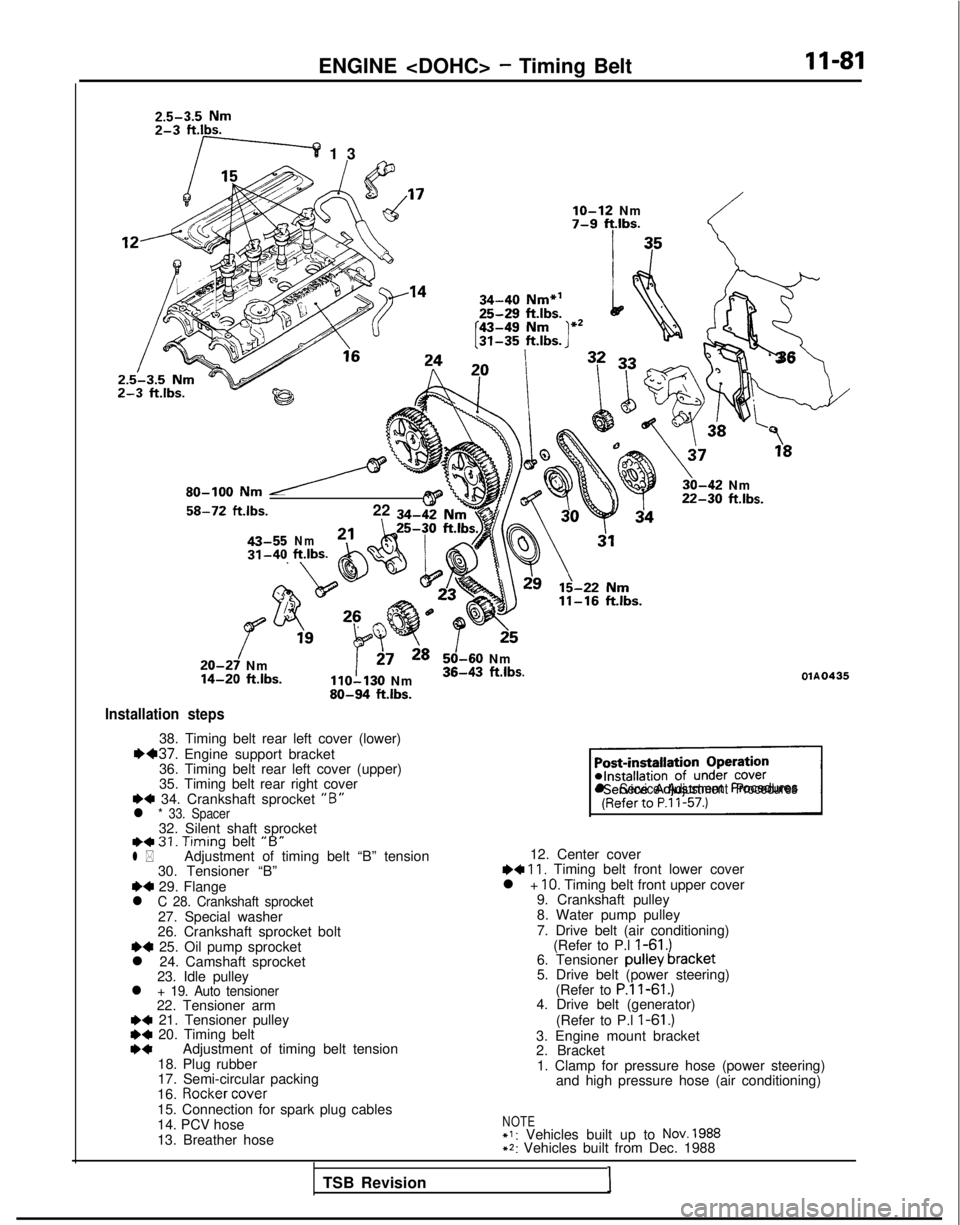
ENGINE
f”.53A51b;m
r----v 1
3
lo-12 Nm
11-16
ftlbs.80-100
Nm y~x-di
58-72ft.lbs.2234!?!I
212543-55Nm 31-40, ff.lbs.b&-.,\‘-
/20-27 Nm
14-20
ftlbs.110;130 Nm80-94
ftlbs.
Installation steps
38. Timing belt rear left cover (lower)1H37. Engine support bracket
36. Timing belt rear left cover (upper)
35. Timing belt rear right cover
+4 34. Crankshaft sprocket “B”l * 33. Spacer32. Silent shaft sprocketI)+ 31. Timing
belt “B”l *Adjustment of timing belt “B” tension
30. Tensioner “B”
~~ 29. Flangel C 28. Crankshaft sprocket27. Special washer
26. Crankshaft sprocket bolt
~~ 25. Oil pump sprocket
l 24. Camshaft sprocket 23. Idle pulley
l + 19. Auto tensioner22. Tensioner arm+a 21. Tensioner pulley*C 20. Timing beltI)*Adjustment of timing belt tension
18. Plug rubber
17. Semi-circular packing
16.
Rocker cover
15. Connection for spark plug cables
14. PCV hose
13. Breather hose
!_-;
‘3
6
\
3,“”
30-42 Nm22-30 ftlbs.
125
50-60 Nm36-43 ftlbs.OlA0435
sl Service Adjustment Procedures
12. Center cover~~ 11, Timing belt front lower cover
l + IO. Timing belt front upper cover
9. Crankshaft pulley
8. Water pump pulley
7. Drive belt (air conditioning) (Refer to P.l
I-61 .)6. Tensioner pulley bracket
5. Drive belt (power steering)
(Refer to
P.ll-61.)4. Drive belt (generator)
(Refer to P.l
I-61 .)3. Engine mount bracket
2. Bracket1. Clamp for pressure hose (power steering) and high pressure hose (air conditioning)
NOTE+I: Vehicles built up to NOV. 1988+2: Vehicles built from Dec. 1988
TSB Revision I
Page 134 of 1273
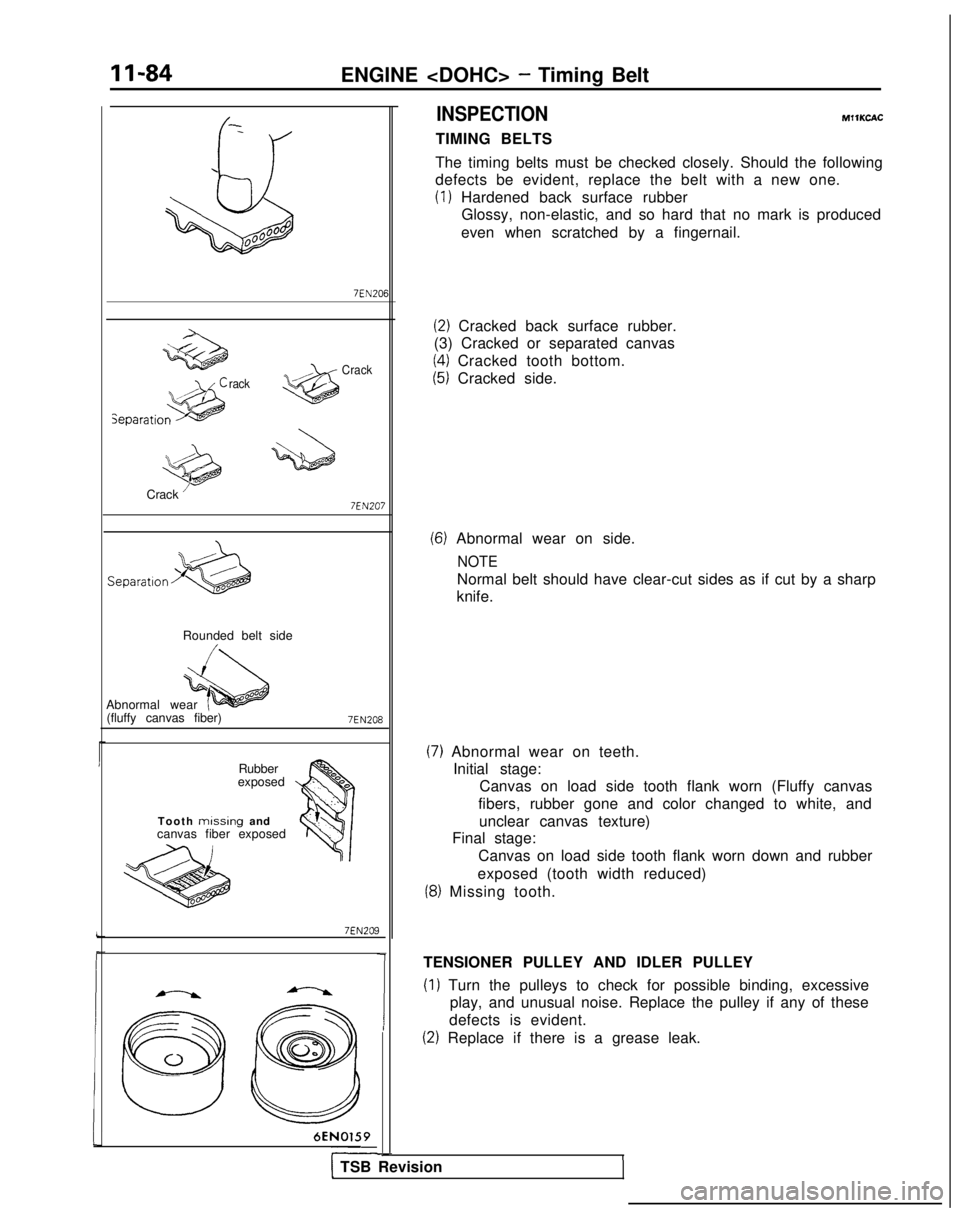
11-84
ENGINE
QdiJ00°00B
rackCrack
Crack ’ 7EN207
Separation
Rounded belt side
Abnormal wear (fluffy canvas fiber)
7EN208
Rubber
exposed
Tooth
missing and
canvas fiber exposed
7EN209
6EN0159
Y
1
-
INSPECTION
TIMING BELTS MIlKCAC
The timing belts must be checked closely. Should the following
defects be evident, replace the belt with a new one.
(1) Hardened back surface rubber Glossy, non-elastic, and so hard that no mark is produced
even when scratched by a fingernail.
(2) Cracked back surface rubber.
(3) Cracked or separated canvas
(4) Cracked tooth bottom.
(5) Cracked side.
(6) Abnormal wear on side.
NOTE
Normal belt should have clear-cut sides as if cut by a sharp
knife.
(7) Abnormal wear on teeth. Initial stage: Canvas on load side tooth flank worn (Fluffy canvas
fibers, rubber gone and color changed to white, and unclear canvas texture)
Final stage:
Canvas on load side tooth flank worn down and rubber
exposed (tooth width reduced)
(8) Missing tooth.
TENSIONER PULLEY AND IDLER PULLEY
(1) Turn the pulleys to check for possible binding, excessive play, and unusual noise. Replace the pulley if any of these
defects is evident.
(2) Replace if there is a grease leak.
I1 TSB Revision
Page 140 of 1273
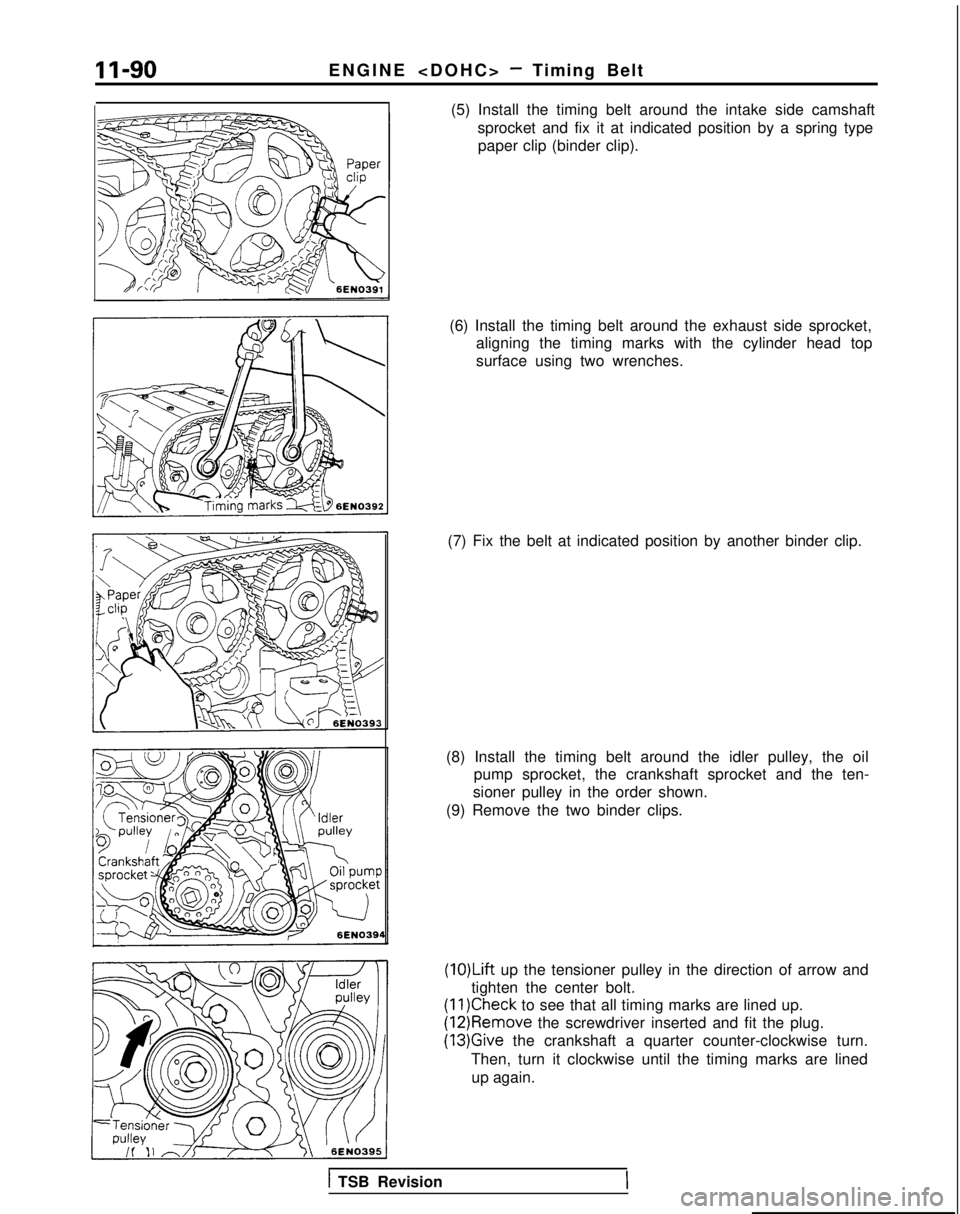
II-90ENGINE
(5) Install the timing belt around the intake side camshaft sprocket and fix it at indicated position by a spring typepaper clip (binder clip).
(6) Install the timing belt around the exhaust side sprocket, aligning the timing marks with the cylinder head top
surface using two wrenches.
(7) Fix the belt at indicated position by another binder clip.
(8) Install the timing belt around the idler pulley, the oil pump sprocket, the crankshaft sprocket and the ten-
sioner pulley in the order shown.
(9) Remove the two binder clips.
(1O)Lift up the tensioner pulley in the direction of arrow and
tighten the center bolt.
(11)Check to see that all timing marks are lined up. (12)Remove
the screwdriver inserted and fit the plug.
(13)Give the crankshaft a quarter counter-clockwise turn.
Then, turn it clockwise until the timing marks are lined up again.
1 TSB Revision